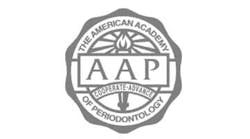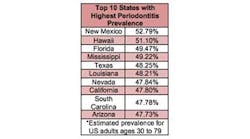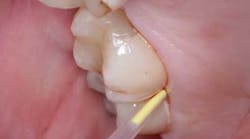Dentists to address global concern over antimicrobial resistance at IDEM singapore
After the publication of alarming reports on antimicrobial resistance, both the EU Commission and USA’s Food Drug Administration have recently announced stricter regulations aimed at curbing the overuse of antimicrobials in the hope of slowing the growing menace of antimicrobial resistance.
In the light of these recent announcements, the selection of Dr. John Molinari and Prof. Ken Hargreaves to give talks on infection management and alternatives to antibiotics at IDEM Singapore 2014 is if not prescient then certainly both apt and timely. IDEM Singapore will be running from April 4-6, 2014.
In November 2013, the European Commission published the 2013 Eurobarometer Survey on antimicrobial resistance (AMR) and the European Centre for Disease Prevention and Control (ECDC) released the latest data on antibiotic resistance in the EU and European Economic Area. Earlier in 2013 the U.S. Centers for Disease Control and Prevention (CDC) also published a review of Antibiotic Resistance Threats. All three reports were sobering reading and, like previous reports from the World Health Organization (WHO) and the Alliance for the Prudent Use of Antibiotics (APUA), they highlighted the growing global problem of antimicrobial resistance.
In a telephone interview, Dr. Molinari, a microbiologist, said, “I have been lecturing doctors and dentists about the risks of antimicrobial resistance for 20 years; it is a growing public health concern around the world.”
Dr. Molinari will be presenting a lecture titled, "Infection Control — Yesterday, Today, and Tomorrow," at the IDEM Singapore 2014 scientific conference, sponsored by the infection control specialist Scican. He believes there are numerous issues involving misperception and the misuse of infection control procedures in all areas of health care that are in conflict with the latest scientific and clinical knowledge. He said, “Antimicrobial resistance, the overuse, and misuse of antimicrobials is an important issue that I will be addressing in my talk at IDEM.”
In an email interview, Prof. Hargreaves also assured us, “I will certainly be covering this topic in my upcoming lecture at IDEM Singapore 2014.”
The professor, an advocate of local antimicrobial therapies in endodontics to reduce bacterial load as an alternative to systemic antibiotics, went on to tell us, “There is growing recognition of the impact of antibiotic resistance as a health threat. In 2013, the U.S. Centers for Disease Control and Prevention (CDC) published an extensive review titled "Antibiotic Resistance Threats in the United States, 2013." This report, together with the 2013 Eurobarometer Survey (ECDC) report, provides compelling evidence for the prudent clinician to understand this issue and to provide appropriate treatment for odontogenic infections.”
Prof. Hargreaves went on to illustrate the problem with some alarming statistics. “The numbers are striking. Every year in the United States, nearly two million people have infections with antibiotic resistant bacteria and 23,000 of these individuals die from their infections. It has been estimated that up to 50% of antibiotic prescriptions are made for patients who do not have a medical indication for these drugs. These facts require a reevaluation of the use of antibiotics in odontogenic infections.”
Prof. Hargreaves believes clinicians should consider all possible alternatives before reaching for the prescription pad. “Local antimicrobial therapies have been demonstrated in endodontic research to dramatically reduce bacterial load, leading to the recognition of the importance of this alternative to systemic antibiotics. Further research in this area is needed, but results to date have led to an evidence-based guideline for treating odontogenic infections.”
Prof. Hargreaves will be covering this and other related topics further in the series of Master Class Lectures, sponsored by the Singapore Dental Association at IDEM Singapore 2014 in April.
This is not a new issue. Back in 1981, the Alliance for the Prudent Use of Antibiotics (APUA) was formed and in 1998 they helped put together the Global Advisory on Antibiotic Resistance Data (GAARD) project in an effort to support and learn from the existing surveillance infrastructure. GAARD brought together the world’s largest surveillance systems, integrating antimicrobial resistance data from the various networks for special studies designed to inform public health policy.
Several of the big pharmaceutical companies agreed to contribute data from their on-going surveillance systems as part of a unique collaboration which saw for the first time the private sector working with public sector entities like the World Health Organization (WHO), the World Health Organization Collaborating Centre on Antimicrobial Resistance, and the United States Center for Disease Control.
Back in 2005, GAARD published its first report, which included contributions from a variety of other prominent systems tracking resistance worldwide as well as the GAARD group. While it unearthed important trends in global drug resistance, the report also exposed the paucity of coordinated local, national, and global surveillance data and called for more thorough and coordinated efforts.
However, this is a call that has met only limited response. It took the EU Commission another eight years before they could announce in 2013 that they had adopted new legislation on the surveillance of AMR which will ensure harmonized monitoring systems in Europe, thus ensuring the comparability of data between its Member States if not the rest of the world.
While the EU and U.S. have improved monitoring and started to put new regulations in place, there has been little or no action in the rest of the world, and especially among developing nations. This leads to Africa, South America, and parts of Asia becoming hotbeds of AMR proliferation, as is the United States, albeit for different reasons. Just as there is no single cause for the increase in AMR, there is no single solution. In the U.S. perhaps the biggest contributing factor is the massive amount of antibiotics used by the animal husbandry industry; about 70% by weight of all the antibiotics is used in the United States.
Another major issue is that much of the remaining 30% prescribed to humans is unnecessary. In the developing worl,d self-medication, out-of-date, or poorly stored drugs, low dosages, uncompleted cycles, as well as counterfeit drugs all fuel the AMR time bomb. While dentistry may not yet be the frontline in the AMR war, the growing threat of AMR behoves all medical professionals, regardless of their field or where in the world they practice, to consider their own actions and how they can do their own small part to help control the problem.
For more information on EU policy, please click here.
For more information on the work of the CDCE, click here.






